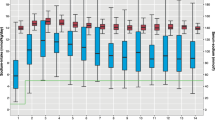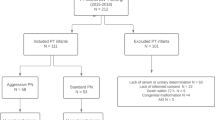Abstract
Background/Objectives:
Recent guidelines for preterm parenteral nutrition (PN) recommend an earlier and higher intake of amino acids (AA) and energy to avoid postnatal catabolism and approximate normal fetal growth. Few investigations explored how early PN may affect electrolyte and water homeostasis. We performed a prospective observational trial to assess the effect of nutrient intake on electrolyte homeostasis and balance.
Subjects/Methods:
During 16 months, all infants ⩽32 weeks were eligible. In the first week of life, we recorded the following daily: electrolytes (plasma and 8-h urine collection), nutritional intake, urine output, body weight, and we calculated sodium (Na) and potassium (K) balance. Infants were divided, for analysis, into three groups of AA intake: low <1.5 g/kg/day (LAA), medium 1.5–2 g/kg/day (MAA) and high >2 g/kg/day (HAA).
Results:
A total of 154 infants were included. HAA group presented lower weight loss. Na balance was influenced by urine output and postnatal age, with little contribution of nutrition. Kalemia and K balance were mainly influenced by AA intake. K balance differed among groups: LAA, −2.3 mmol/kg/week; MAA, 1.1 mmol/kg/week; and HAA 2.6 mmol/kg/week (P<0.0001). In the HAA group, plasma and urine K were significantly lower and non-oliguric hyperkalemia was reduced.
Conclusions:
Na homeostasis was very slightly modified by early nutrition, suggesting that a negative Na balance is obligatory after birth. We showed that AA intake strongly affects K balance, minimize hyperkalemia and reduces weight loss. As K balance is strictly linked to cellular metabolism, we speculate that early nutrition may inhibit cellular catabolism and reduce the contraction of intracellular water compartment.
This is a preview of subscription content, access via your institution
Access options
Subscribe to this journal
Receive 12 print issues and online access
$259.00 per year
only $21.58 per issue
Buy this article
- Purchase on Springer Link
- Instant access to full article PDF
Prices may be subject to local taxes which are calculated during checkout



Similar content being viewed by others
References
Agren J, Siors G, Sedin G (1998). Transepidermal water loss in infant born at 24 and 25 weeks of gestation. Acta Paediatr 87, 1185–1190.
Elstgeest LE, Martens SE, Lopriore E, Walther FJ, te Pas AB (2010). Does parenteral nutrition influence electrolyte and fluid balance in preterm infants in the first days after birth? PLoS One 5, e9033.
Gawlowski Z, Aladangady N, Coen PG (2006). Hypernatraemia in preterm infants born at less than 27 weeks gestation. J Paediatr Child Health 42, 771–774.
Gouyon JB, Sonveau N, d’Athis P, Chaillot B (1994). Accuracy of urine output measurement with regular disposable nappies. Pediatr Nephrol 8, 88–90.
Hartnoll G, Bétrémieux P, Modi N (2000). Randomised controlled trial of postnatal sodium supplementation on oxygen dependency and body weight in 25–30 week gestational age infants. Arch Dis Child Fetal Neonatal Ed 82, 19–23.
Heimler R, Doumas BT, Jendrzejczak BM, Nemeth PB, Hoffman RG, Nelin LD (1993). Relationship between nutrition, weight change, and fluid compartments in preterm infants during the first week of life. J Pediatr 122, 110–114.
Iacobelli S, Bonsante F, Vintejoux A, Gouyon JB (2010). Standardized parenteral nutrition in preterm infants: early impact on fluid and electrolyte balance. Neonatology 98, 84–90.
Koletzko B, Goulet O, Hunt J, Krohn K, Shamir R (2005). Guidelines on Paediatric Parenteral Nutrition of the European Society of Pediatric Gastroenterology, Hepatology and Nutrition (ESPGHAN) and the European Society for Clinical Nutrition and Metabolism (ESPEN), supported by the European Society of Paediatric Research (ESPR). J Pediatr Gastroenterol Nutr 41 (Suppl 2), S1–87.
Lorenz JM, Kleinman LI, Ahmed G, Markarian K (1995). Phases of fluid and electrolytes homeostasis in the extremely low birth weight infant. Pediatrics 96, 484–489.
Matsuo Y, Hasegawa K, Doi Y, Kinugasa A, Uchiyama M, Sawada T (1995). Erythrocyte sodium-potassium transport in hyperkalaemic and normokalaemic infants. Eur J Pediatr 154, 571–576.
Mitton SG, Burston D, Brueton MJ, Kovar IZ (1993). Plasma aminoacids profiles in preterm infants receiving Vamin 9 or Vamin infant. Early Hum Dev 32, 71–78.
Modi N (2003). Clinical implications of postnatal alterations in body water distribution. Semin Neonatol 8, 301–306.
Modi N, Hutton JL (1990). The influence of postnatal respiratory adaptation on sodium handling in preterm neonates. Early Hum Dev 21, 11–20.
Omar SA, DeCristofaro JD, Agarwal BI, La Gamma EF (2000). Effect of prenatal steroids on potassium balance in extremely low birth weight neonates. Pediatrics 106, 561–567.
Rigo J, De Curtis M (2004). Parenteral nutrition in premature infants. In: Guandalini S (ed.). Textbook of Pediatric Gastroenterology and Nutrition. Taylor & Francis: NY, USA, 37, pp 619–637.
Rivera Jr A, Bell EF, Bier DM (1993). Effect of intravenous amino acids on protein metabolism of preterm infant during the first three days of life. Pediatr Res 33, 106–111.
Spady DW, Schiff D, Szymanski WA (1987). A description of the changing body composition of the growing premature infant. J Pediatr Gastroenterol Nutr 6, 730–738.
Stefano JL, Norman ME, Morales MC, Goplerud GM, Mishra OP, Delivoria-Papadopoulos M (1993). Decreased erythrocyte Na+, K(+)-ATPase activity associated with cellular potassium loss in extremely low birth weight infants with nonoliguric hyperkalemia. J Pediatr 122, 276–284.
Sulyok E (2008). Renal aspect of sodium metabolism in the fetus and neonate. In: Neonatology question and controversies, 1st edn. Saunders Elsevier Co.: Philadelphia, pp 23–53.
Thureen PJ, Melara D, Hennessey PV, Hay Jr WW (2003). Effect of low versus high intravenous amino acid intake on very low birth weight infants in the early neonatal period. Pediatr Res 53, 24–32.
Van Goudoever JB, Colen T, Wattimena JL, Huijmans JG, Carnielli VP, Sauer PJ (1995). Immediate commencement of amino acid supplementation in preterm infants: effect on serum amino acid concentrations and protein kinetics on the first day of life. J Pediatr 127, 458–465.
Van Lingen RA, Van Goudover JB, Luijendijk IH, Wattimena JL, Sauer PJ (1992). Effects of early amino acid administration during total parenteral nutrition on protein metabolism in preterm infants. Cli Sci 82, 199–203.
Wada M, Kusuna S, Takahashi N, Nishida H (2008). Fluid and electrolyte balance in extremely preterm infants <24 weeks of gestation in the first week of life. Pediatr Int 50, 331–336.
Wahlig TM, Gatto CW, Boros SJ, Mammel MC, Mills MM, Georgieff MK (1994). Metabolic response of preterm infants to variable degrees of respiratory illness. J Pediatr 124, 283–288.
Yaseen H (2009). Nonoliguric hyperkalemia in neonates. A case-controlled study. Am J Perinatol 26, 185–189.
Author information
Authors and Affiliations
Corresponding author
Ethics declarations
Competing interests
The authors declare no conflict of interest.
Rights and permissions
About this article
Cite this article
Bonsante, F., Iacobelli, S., Chantegret, C. et al. The effect of parenteral nitrogen and energy intake on electrolyte balance in the preterm infant. Eur J Clin Nutr 65, 1088–1093 (2011). https://doi.org/10.1038/ejcn.2011.79
Received:
Revised:
Accepted:
Published:
Issue Date:
DOI: https://doi.org/10.1038/ejcn.2011.79



